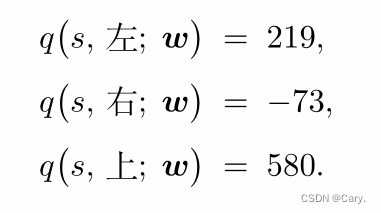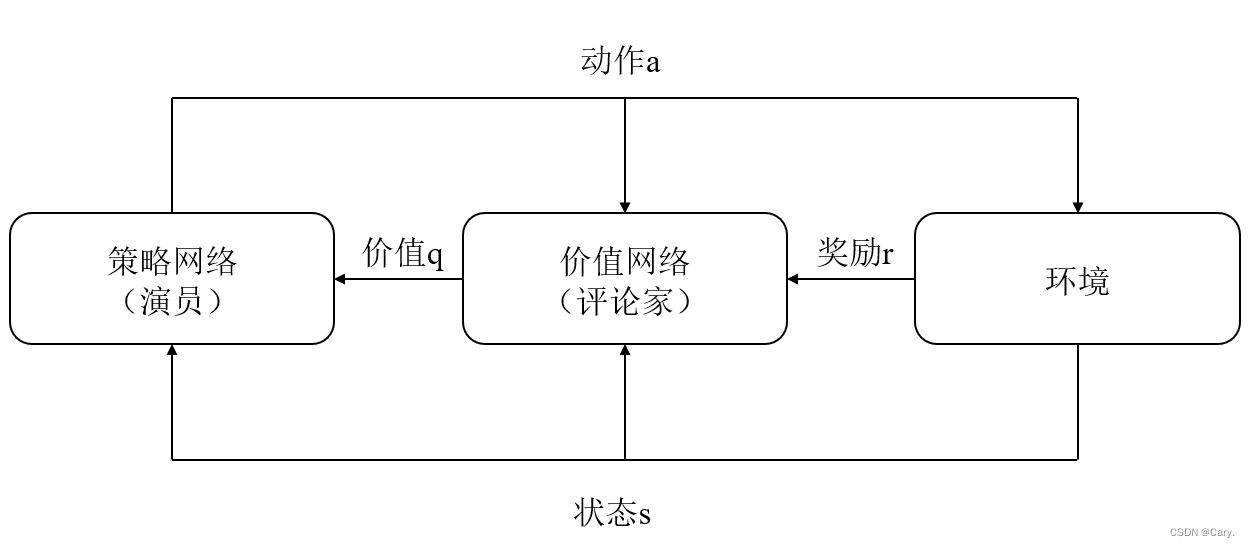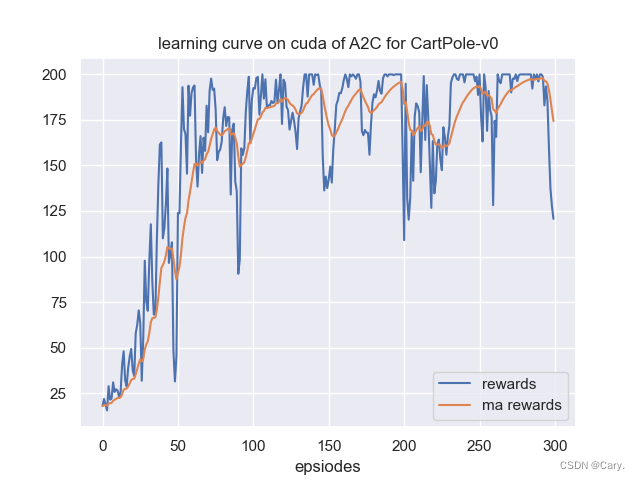本文主要参考王树森老师的强化学习课程
1.A2C算法原理
A2C算法是策略学习中比较经典的一个算法,是在 Barto 等人1983年提出的。我们知道策略梯度方法用策略梯度更新策略网络参数 θ,从而增大目标函数,即下面的随机梯度:

Actor-Critic 方法中用一个神经网络近似动作价值函数 Q π (s,a),这个神经网络叫做“价值网络”,记为 q(s,a;w),其中的 w 表示神经网络中可训练的参数。价值网络的输入是状态 s,输出是每个动作的价值。动作空间 A 中有多少种动作,那么价值网络的输出就是多少维的向量,向量每个元素对应一个动作。举个例子,动作空间是 A = {左,右,上},价值网络的输出是 :

神经网络可以采用以下结构:

虽然价值网络 q(s,a;w) 与DQN有相同的结构,但是两者的意义不同,训练算法也不同。、
- 价值网络是对动作价值函数 Q π (s,a) 的近似。而 DQN 则是对最优动作价值函数Q ⋆ (s,a) 的近似。
- 对价值网络的训练使用的是SARSA算法,它属于同策略,不能用经验回放。对DQN的训练使用的是 Q 学习算法,它属于异策略,可以用经验回放。
Actor-Critic 翻译成“演员—评论家”方法。策略网络 π(a|s;θ) 相当于演员,它基于状态 s 做出动作 a。价值网络 q(s,a;w) 相当于评论家,它给演员的表现打分,量化在状态 s的情况下做出动作 a 的好坏程度。策略网络(演员)和价值网络(评委)的关系如下图所示。

2. A2C算法训练流程
设当前策略网络参数是θnow ,价值网络参数是Wnow 。执行下面的步骤,将参数更新成 θnew 和 Wnew :

3.A2C代码实现
基于pytorch在gym基础环境中选择经典环境cartpole-v0倒立摆进行验证。
3.1 算法代码:
import torch.optim as optim
import torch.nn as nn
import torch.nn.functional as F
from torch.distributions import Categorical
class ActorCritic(nn.Module):
''' A2C网络模型,包含一个Actor和Critic
'''
def __init__(self, input_dim, output_dim, hidden_dim):
super(ActorCritic, self).__init__()
self.critic = nn.Sequential(
nn.Linear(input_dim, hidden_dim),
nn.ReLU(),
nn.Linear(hidden_dim, 1)
)
self.actor = nn.Sequential(
nn.Linear(input_dim, hidden_dim),
nn.ReLU(),
nn.Linear(hidden_dim, output_dim),
nn.Softmax(dim=1),
)
def forward(self, x):
value = self.critic(x)
probs = self.actor(x)
dist = Categorical(probs)
return dist, value
class A2C:
''' A2C算法
'''
def __init__(self,state_dim,action_dim,cfg) -> None:
self.gamma = cfg.gamma
self.device = cfg.device
self.model = ActorCritic(state_dim, action_dim, cfg.hidden_size).to(self.device)
self.optimizer = optim.Adam(self.model.parameters())
def compute_returns(self,next_value, rewards, masks):
R = next_value
returns = []
for step in reversed(range(len(rewards))):
R = rewards[step] + self.gamma * R * masks[step]
returns.insert(0, R)
return returns
3.2 实验代码:
import sys
import os
curr_path = os.path.dirname(os.path.abspath(__file__)) # 当前文件所在绝对路径
parent_path = os.path.dirname(curr_path) # 父路径
sys.path.append(parent_path) # 添加路径到系统路径
import gym
import numpy as np
import torch
import torch.optim as optim
import datetime
from common.multiprocessing_env import SubprocVecEnv
from a2c import ActorCritic
from common.utils import save_results, make_dir
from common.utils import plot_rewards
curr_time = datetime.datetime.now().strftime("%Y%m%d-%H%M%S") # 获取当前时间
algo_name = 'A2C' # 算法名称
env_name = 'CartPole-v0' # 环境名称
class A2CConfig:
def __init__(self) -> None:
self.algo_name = algo_name# 算法名称
self.env_name = env_name # 环境名称
self.n_envs = 8 # 异步的环境数目
self.gamma = 0.99 # 强化学习中的折扣因子
self.hidden_dim = 256
self.lr = 1e-3 # learning rate
self.max_frames = 30000
self.n_steps = 5
self.device = torch.device("cuda" if torch.cuda.is_available() else "cpu")
class PlotConfig:
def __init__(self) -> None:
self.algo_name = algo_name # 算法名称
self.env_name = env_name # 环境名称
self.device = torch.device("cuda" if torch.cuda.is_available() else "cpu") # 检测GPU
self.result_path = curr_path+"/outputs/" + self.env_name + \
'/'+curr_time+'/results/' # 保存结果的路径
self.model_path = curr_path+"/outputs/" + self.env_name + \
'/'+curr_time+'/models/' # 保存模型的路径
self.save = True # 是否保存图片
def make_envs(env_name):
def _thunk():
env = gym.make(env_name)
env.seed(2)
return env
return _thunk
def ceshi_env(env,model,vis=False):
state = env.reset()
if vis: env.render()
done = False
total_reward = 0
while not done:
state = torch.FloatTensor(state).unsqueeze(0).to(cfg.device)
dist, _ = model(state)
next_state, reward, done, _ = env.step(dist.sample().cpu().numpy()[0])
state = next_state
if vis: env.render()
total_reward += reward
return total_reward
def compute_returns(next_value, rewards, masks, gamma=0.99):
R = next_value
returns = []
for step in reversed(range(len(rewards))):
R = rewards[step] + gamma * R * masks[step]
returns.insert(0, R)
return returns
def train(cfg,envs):
print('开始训练!')
print(f'环境:{cfg.env_name}, 算法:{cfg.algo_name}, 设备:{cfg.device}')
env = gym.make(cfg.env_name) # a single env
env.seed(10)
state_dim = envs.observation_space.shape[0]
action_dim = envs.action_space.n
model = ActorCritic(state_dim, action_dim, cfg.hidden_dim).to(cfg.device)
optimizer = optim.Adam(model.parameters())
frame_idx = 0
test_rewards = []
test_ma_rewards = []
state = envs.reset()
while frame_idx < cfg.max_frames:
log_probs = []
values = []
rewards = []
masks = []
entropy = 0
# rollout trajectory
for _ in range(cfg.n_steps):
state = torch.FloatTensor(state).to(cfg.device)
dist, value = model(state)
action = dist.sample()
next_state, reward, done, _ = envs.step(action.cpu().numpy())
log_prob = dist.log_prob(action)
entropy += dist.entropy().mean()
log_probs.append(log_prob)
values.append(value)
rewards.append(torch.FloatTensor(reward).unsqueeze(1).to(cfg.device))
masks.append(torch.FloatTensor(1 - done).unsqueeze(1).to(cfg.device))
state = next_state
frame_idx += 1
if frame_idx % 100 == 0:
test_reward = np.mean([ceshi_env(env,model) for _ in range(10)])
print(f"frame_idx:{frame_idx}, test_reward:{test_reward}")
test_rewards.append(test_reward)
if test_ma_rewards:
test_ma_rewards.append(0.9*test_ma_rewards[-1]+0.1*test_reward)
else:
test_ma_rewards.append(test_reward)
# plot(frame_idx, test_rewards)
next_state = torch.FloatTensor(next_state).to(cfg.device)
_, next_value = model(next_state)
returns = compute_returns(next_value, rewards, masks)
log_probs = torch.cat(log_probs)
returns = torch.cat(returns).detach()
values = torch.cat(values)
advantage = returns - values
actor_loss = -(log_probs * advantage.detach()).mean()
critic_loss = advantage.pow(2).mean()
loss = actor_loss + 0.5 * critic_loss - 0.001 * entropy
optimizer.zero_grad()
loss.backward()
optimizer.step()
print('完成训练!')
return test_rewards, test_ma_rewards
if __name__ == "__main__":
cfg = A2CConfig()
plot_cfg = PlotConfig()
envs = [make_envs(cfg.env_name) for i in range(cfg.n_envs)]
envs = SubprocVecEnv(envs)
# 训练
rewards,ma_rewards = train(cfg,envs)
make_dir(plot_cfg.result_path,plot_cfg.model_path)
save_results(rewards, ma_rewards, tag='train', path=plot_cfg.result_path) # 保存结果
plot_rewards(rewards, ma_rewards, plot_cfg, tag="train") # 画出结果
3.2 一些依赖的文件(common文件夹)
3.2.1 multiprocessing_env.py(来自 openai baseline,用于多线程环境)
# 该代码来自 openai baseline,用于多线程环境
# https://github.com/openai/baselines/tree/master/baselines/common/vec_env
import numpy as np
from multiprocessing import Process, Pipe
def worker(remote, parent_remote, env_fn_wrapper):
parent_remote.close()
env = env_fn_wrapper.x()
while True:
cmd, data = remote.recv()
if cmd == 'step':
ob, reward, done, info = env.step(data)
if done:
ob = env.reset()
remote.send((ob, reward, done, info))
elif cmd == 'reset':
ob = env.reset()
remote.send(ob)
elif cmd == 'reset_task':
ob = env.reset_task()
remote.send(ob)
elif cmd == 'close':
remote.close()
break
elif cmd == 'get_spaces':
remote.send((env.observation_space, env.action_space))
else:
raise NotImplementedError
class VecEnv(object):
"""
An abstract asynchronous, vectorized environment.
"""
def __init__(self, num_envs, observation_space, action_space):
self.num_envs = num_envs
self.observation_space = observation_space
self.action_space = action_space
def reset(self):
"""
Reset all the environments and return an array of
observations, or a tuple of observation arrays.
If step_async is still doing work, that work will
be cancelled and step_wait() should not be called
until step_async() is invoked again.
"""
pass
def step_async(self, actions):
"""
Tell all the environments to start taking a step
with the given actions.
Call step_wait() to get the results of the step.
You should not call this if a step_async run is
already pending.
"""
pass
def step_wait(self):
"""
Wait for the step taken with step_async().
Returns (obs, rews, dones, infos):
- obs: an array of observations, or a tuple of
arrays of observations.
- rews: an array of rewards
- dones: an array of "episode done" booleans
- infos: a sequence of info objects
"""
pass
def close(self):
"""
Clean up the environments' resources.
"""
pass
def step(self, actions):
self.step_async(actions)
return self.step_wait()
class CloudpickleWrapper(object):
"""
Uses cloudpickle to serialize contents (otherwise multiprocessing tries to use pickle)
"""
def __init__(self, x):
self.x = x
def __getstate__(self):
import cloudpickle
return cloudpickle.dumps(self.x)
def __setstate__(self, ob):
import pickle
self.x = pickle.loads(ob)
class SubprocVecEnv(VecEnv):
def __init__(self, env_fns, spaces=None):
"""
envs: list of gym environments to run in subprocesses
"""
self.waiting = False
self.closed = False
nenvs = len(env_fns)
self.nenvs = nenvs
self.remotes, self.work_remotes = zip(*[Pipe() for _ in range(nenvs)])
self.ps = [Process(target=worker, args=(work_remote, remote, CloudpickleWrapper(env_fn)))
for (work_remote, remote, env_fn) in zip(self.work_remotes, self.remotes, env_fns)]
for p in self.ps:
p.daemon = True # if the main process crashes, we should not cause things to hang
p.start()
for remote in self.work_remotes:
remote.close()
self.remotes[0].send(('get_spaces', None))
observation_space, action_space = self.remotes[0].recv()
VecEnv.__init__(self, len(env_fns), observation_space, action_space)
def step_async(self, actions):
for remote, action in zip(self.remotes, actions):
remote.send(('step', action))
self.waiting = True
def step_wait(self):
results = [remote.recv() for remote in self.remotes]
self.waiting = False
obs, rews, dones, infos = zip(*results)
return np.stack(obs), np.stack(rews), np.stack(dones), infos
def reset(self):
for remote in self.remotes:
remote.send(('reset', None))
return np.stack([remote.recv() for remote in self.remotes])
def reset_task(self):
for remote in self.remotes:
remote.send(('reset_task', None))
return np.stack([remote.recv() for remote in self.remotes])
def close(self):
if self.closed:
return
if self.waiting:
for remote in self.remotes:
remote.recv()
for remote in self.remotes:
remote.send(('close', None))
for p in self.ps:
p.join()
self.closed = True
def __len__(self):
return self.nenvs
3.2.2 utils.py(主要是文件创建与绘图函数)
import os
import numpy as np
from pathlib import Path
import matplotlib.pyplot as plt
# import seaborn as sns
from matplotlib.font_manager import FontProperties # 导入字体模块
def chinese_font():
''' 设置中文字体,注意需要根据自己电脑情况更改字体路径,否则还是默认的字体
'''
try:
font = FontProperties(
fname='/System/Library/Fonts/STHeiti Light.ttc', size=15) # fname系统字体路径,此处是mac的
except:
font = None
return font
def plot_rewards_cn(rewards, ma_rewards, plot_cfg, tag='train'):
''' 中文画图
'''
# sns.set()
plt.figure()
plt.title(u"{}环境下{}算法的学习曲线".format(plot_cfg.env_name,
plot_cfg.algo_name), fontproperties=chinese_font())
plt.xlabel(u'回合数', fontproperties=chinese_font())
plt.plot(rewards)
plt.plot(ma_rewards)
plt.legend((u'奖励', u'滑动平均奖励',), loc="best", prop=chinese_font())
if plot_cfg.save:
plt.savefig(plot_cfg.result_path+f"{tag}_rewards_curve_cn")
# plt.show()
def plot_rewards(rewards, ma_rewards, plot_cfg, tag='train'):
# sns.set()
plt.figure() # 创建一个图形实例,方便同时多画几个图
plt.title("learning curve on {} of {} for {}".format(
plot_cfg.device, plot_cfg.algo_name, plot_cfg.env_name))
plt.xlabel('epsiodes')
plt.plot(rewards, label='rewards')
plt.plot(ma_rewards, label='ma rewards')
plt.legend()
if plot_cfg.save:
plt.savefig(plot_cfg.result_path+"{}_rewards_curve".format(tag))
plt.show()
def plot_losses(losses, algo="DQN", save=True, path='./'):
# sns.set()
plt.figure()
plt.title("loss curve of {}".format(algo))
plt.xlabel('epsiodes')
plt.plot(losses, label='rewards')
plt.legend()
if save:
plt.savefig(path+"losses_curve")
plt.show()
def save_results(rewards, ma_rewards, tag='train', path='./results'):
''' 保存奖励
'''
np.save(path+'{}_rewards.npy'.format(tag), rewards)
np.save(path+'{}_ma_rewards.npy'.format(tag), ma_rewards)
print('结果保存完毕!')
def make_dir(*paths):
''' 创建文件夹
'''
for path in paths:
Path(path).mkdir(parents=True, exist_ok=True)
def del_empty_dir(*paths):
''' 删除目录下所有空文件夹
'''
for path in paths:
dirs = os.listdir(path)
for dir in dirs:
if not os.listdir(os.path.join(path, dir)):
os.removedirs(os.path.join(path, dir))
4 实验结果

版权归原作者 Cary. 所有, 如有侵权,请联系我们删除。